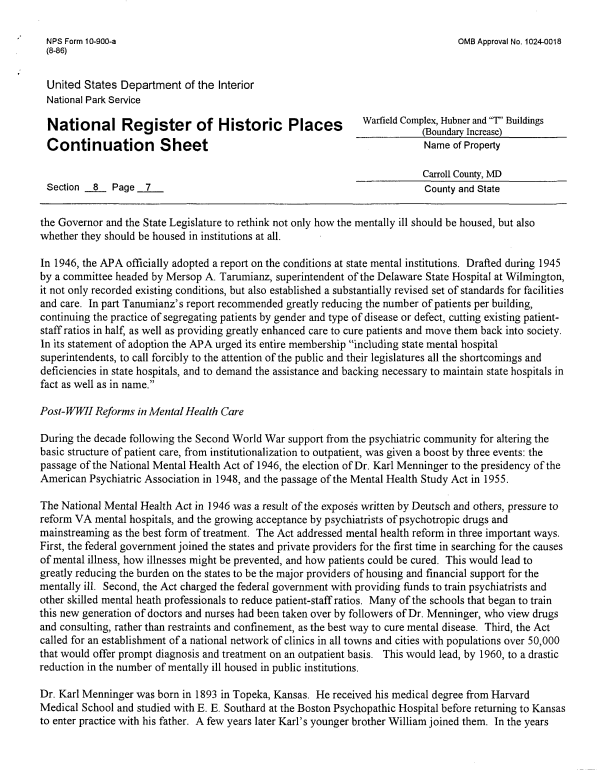 |
||||
|
DEPARTMENT OF HOUSING AND COMMUNITY DEVELOPMENT, MARYLAND HISTORICAL TRUST (Historic Sites Survey) var.d. MSA SE16-7 Image No: se16-7-0320 Enlarge and print image (82K) |
 |
||||
|
DEPARTMENT OF HOUSING AND COMMUNITY DEVELOPMENT, MARYLAND HISTORICAL TRUST (Historic Sites Survey) var.d. MSA SE16-7 Image No: se16-7-0320 Enlarge and print image (82K) |
| NPS Form 10-900-a OMB Approval No. 1024-0018 (8-86) United States Department of the Interior National Park Service National Register of Historic Places WaifiddCompSd^easI)Buildinss Continuation Sheet Name of Property Carroll County, MD Section 8 Page 7 County and State the Governor and the State Legislature to rethink not only how the mentally ill should be housed, but also whether they should be housed in institutions at all. In 1946, the APA officially adopted a report on the conditions at state mental institutions. Drafted during 1945 by a committee headed by Mersop A. Tarumianz, superintendent of the Delaware State Hospital at Wilmington, it not only recorded existing conditions, but also established a substantially revised set of standards for facilities and care. In part Tanumianz's report recommended greatly reducing the number of patients per building, continuing the practice of segregating patients by gender and type of disease or defect, cutting existing patient-staff ratios in half, as well as providing greatly enhanced care to cure patients and move them back into society. In its statement of adoption the APA urged its entire membership "including state mental hospital superintendents, to call forcibly to the attention of the public and their legislatures all the shortcomings and deficiencies in state hospitals, and to demand the assistance and backing necessary to maintain state hospitals in fact as well as in name." Post-WWIIReforms in Mental Health Care During the decade following the Second World War support from the psychiatric community for altering the basic structure of patient care, from institutionalization to outpatient, was given a boost by three events: the passage of the National Mental Health Act of 1946, the election of Dr. Karl Menninger to the presidency of the American Psychiatric Association in 1948, and the passage of the Mental Health Study Act in 1955. The National Mental Health Act in 1946 was a result of the exposes written by Deutsch and others, pressure to reform VA mental hospitals, and the growing acceptance by psychiatrists of psychotropic drugs and mainstreaming as the best form of treatment. The Act addressed mental health reform in three important ways. First, the federal government joined the states and private providers for the first time in searching for the causes of mental illness, how illnesses might be prevented, and how patients could be cured. This would lead to greatly reducing the burden on the states to be the major providers of housing and financial support for the mentally ill. Second, the Act charged the federal government with providing funds to train psychiatrists and other skilled mental heath professionals to reduce patient-staff ratios. Many of the schools that began to train this new generation of doctors and nurses had been taken over by followers of Dr. Menninger, who view drugs and consulting, rather than restraints and confinement, as the best way to cure mental disease. Third, the Act called for an establishment of a national network of clinics in all towns and cities with populations over 50,000 that would offer prompt diagnosis and treatment on an outpatient basis. This would lead, by 1960, to a drastic reduction in the number of mentally ill housed in public institutions. Dr. Karl Menninger was born in 1893 in Topeka, Kansas. He received his medical degree from Harvard Medical School and studied with E. E. Southard at the Boston Psychopathic Hospital before returning to Kansas to enter practice with his father. A few years later Karl's younger brother William joined them. In the years |